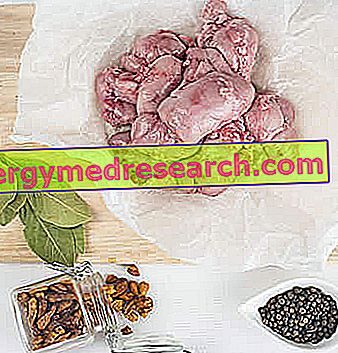Toxoplasmosis is a widespread parasitic disease among warm-blooded animals, including humans. An endocellular protozoan, known as Toxoplasma gondii, is responsible for the disease.
Man can become infected through contact with infected animals (especially cats) or by ingesting raw food (especially pork and raw sheep), contaminated by the parasite or its eggs.
Causes and Contagion

The definitive host of this PARASITE is the cat (in which sexual reproduction takes place), while the intermediate host can be represented by many other warm-blooded animals, such as birds, flies, worms or the human being.
In humans, toxoplasma is responsible for toxoplasmosis, a subtle disease that can cause fetal abortions or mental delays.
The cat emits with the feces the cysts of the parasite that go then to infect the organisms that make contact with the infected excrements. The parasite thus enters, just to cite an example, inside an earthworm which in turn transmits toxoplasmosis to a sparrow, subsequently captured and eaten by a healthy cat.
Particularly interesting is the association between Toxoplasma gondii infection in the mouse and its suicidal inclination
If this cat has intercourse with a pregnant woman it is possible that the lady is affected by toxoplasmosis. Such contagion may for example occur during caresses (taking contact with the feline's saliva) or during litter cleaning. The risk is greater if you come into contact with a country cat, especially if you are elderly. In a study conducted on a population of 700 cats living in Lazio and Tuscany, 36.4% of the animals were positive.
To learn more: Role of the cat in the transmission of toxoplasmosis to humans
In recent years, this risk factor has however been reduced and cats are no longer considered to be the main culprits of the infection.
In fact, there is also the possibility that cat feces are deposited near grass or vegetables for zootechnical use. If a cow eats such contaminated food, the parasite can be found in butchered meats and infect humans (in many areas of the world 10-30% of pork, sheep and lamb contain toxoplasma cysts; of the parasite in beef meat).
Finally, even if this is very rare, it is possible to contract the disease through blood transfusion and / or organ transplants.
To learn more: In what ways can toxoplasmosis be contracted?
Food Cooking and Immune System
Fortunately the human immune system is able to defend itself from the infection of Toxoplasma gondii ; furthermore the parasite is eliminated by cooking food.
If the person who contracts a toxoplasmosis has an efficient immune system, he remains protected throughout his life, since his body produces antibodies and lymphocytes specific for the disease.
Unfortunately in particular conditions the human immune system can go into crisis and become ineffective in fighting this dangerous parasite. This is the case, for example, of patients who are immunosuppressed because they are HIV positive and as such susceptible to frequent relapses and complications.
To learn more: What are the possible course of toxoplasmosis?
Risks in Pregnancy
If the woman is infected in the first weeks of pregnancy, the placenta offers good protection, preventing the passage of the toxoplasma to the fetus. However, in the few cases where this defense does not work, the damage to the child can be very serious, leading to abortion or serious mental delays.
- The risk of maternal-fetal transmission of Toxoplasma is low at the beginning of pregnancy (5-15% in the first trimester) and increases with the progression of gestational age (20-40% in the second trimester and 50-60% in the third trimester ).
- The risk of severe disease in the fetus (brain and ocular lesions) is greater if maternal-fetal transmission occurs in the first half of pregnancy, while at the end of pregnancy it does not cause evident fetal damage at birth.
- Only 5-10% of newborns with congenital infections have severe illness, while most children with congenital infections are asymptomatic, although eye damage may develop even after many years
After the first trimester of pregnancy, the transmission of the disease through the placenta becomes more and more frequent, but the severity of the damage it causes tends to gradually decrease.
To learn more: Toxoplasmosis: risks for pregnant women
Symptoms
To learn more: Toxoplasmosis symptoms
Generally the symptoms of toxoplasmosis appear from a week to a month after the infection.
In many immunocompetent people the disease is completely asymptomatic and is readily blocked by the immune system.
In immunosuppressed subjects the symptoms of the disease are numerous, since toxoplasmosis can affect the kidneys, liver, bones, lungs, nervous system and eyes. The frequent form is the lymphadenopathic form, characterized by the simultaneous presence of not elevated fever, asthenia, anorexia, exanthema.

Diagnosis
See the insights:
How is toxoplasmosis diagnosed?
Toxo test: what is the result and how is it interpreted?
Toxoplasmosis in pregnancy: how is the transmission of the infection to the fetus ascertained?
Prevention
To learn more: How to prevent toxoplasmosis?
- The prevention of toxoplasmosis is based first of all on the exclusive consumption of cooked meats and on the observance of the fundamental hygienic norms (to wash hands after meals, after gardening operations or games with the earth, after handling raw meat).
- To prevent toxoplasmosis, great care must be taken in avoiding the consumption of sliced meat and uncooked meat (fresh sausage, carpaccio, sausages), especially if it is of uncontrolled origin (eg purchased by a small breeder).
- Avoid raw milk or boil it before consumption;
- Wash the fruit very well, especially the vegetables, especially if harvested in vegetable gardens where cats have free access;
- If you are traveling to developing countries, especially in hot and humid climates, it is important to pay close attention to the water you drink.
- If you have a domestic cat at home, it is important to change the litter frequently (once a day). This operation, which should preferably be delegated to third parties, must be carried out daily (since after the deposition the oocysts take on average 2-3 days to become infectious), wearing rubber gloves.
- Always carry out gardening using a pair of gloves and avoid bringing to the mouth the dirty hands in which the cat may have defecated.
- To prevent toxoplasma infection it is finally important to avoid feeding the cat with meat or viscera (liver, lung and other offal) raw and / or undercooked.
Do you know the Rules for the Prevention of Toxoplasmosis? Take the Quiz and Discover the Answer!
Care
To learn more: Drugs to treat toxoplasmosis
If toxoplasmosis is contracted during pregnancy, it is possible to prevent the transmission of the infection to the fetus through specific antibiotic treatments. The most used drug is called spiramycin but there are other specific ones for particular complications and equally effective.
If this transmission has already taken place, there are still combinations of antibiotics that can prevent the disease from evolving. If the diagnosis is premature then there is a good chance that the child will not suffer damage or that they are very modest.
If the pregnancy is planned, a simple test to be carried out before starting it (Toxo-test) can show the presence of specific antibodies for toxoplasmosis and the degree of susceptibility of the mother to the disease. Otherwise, this test must still be carried out within the first eight weeks of gestation.



